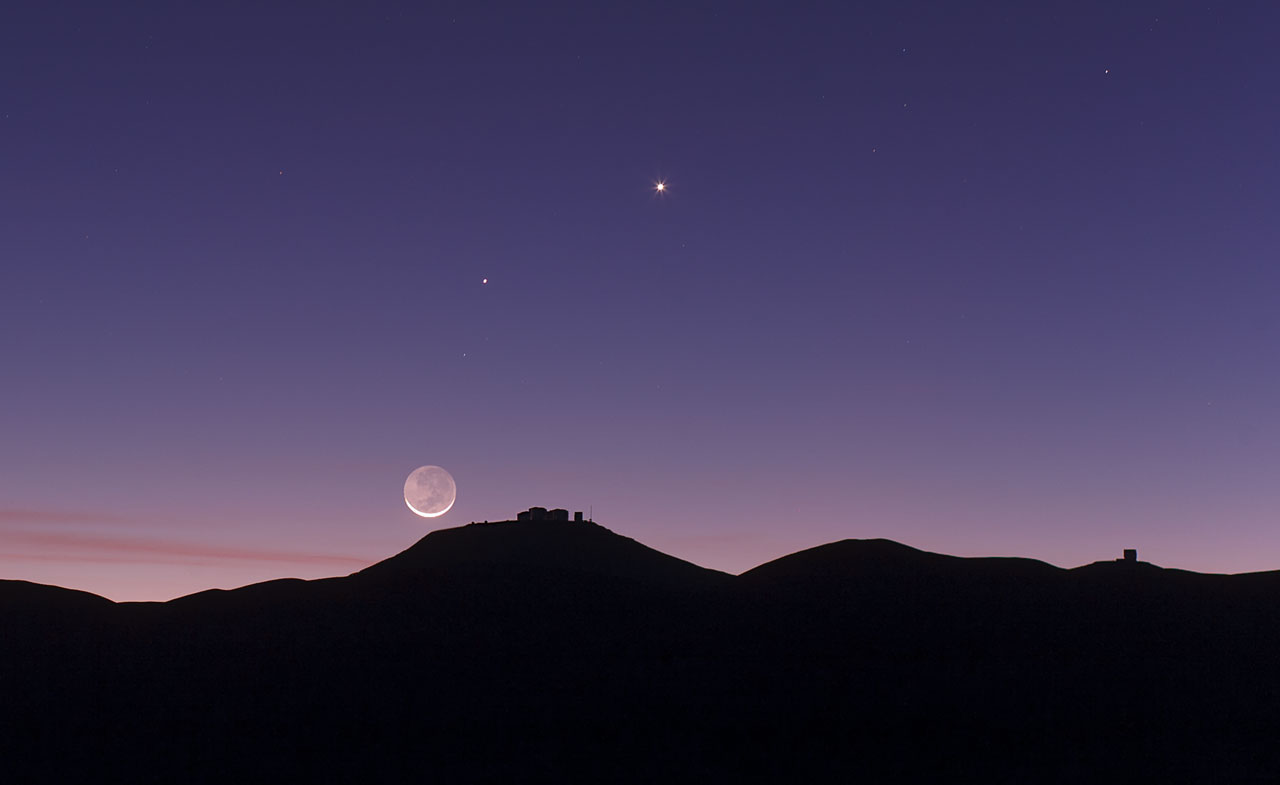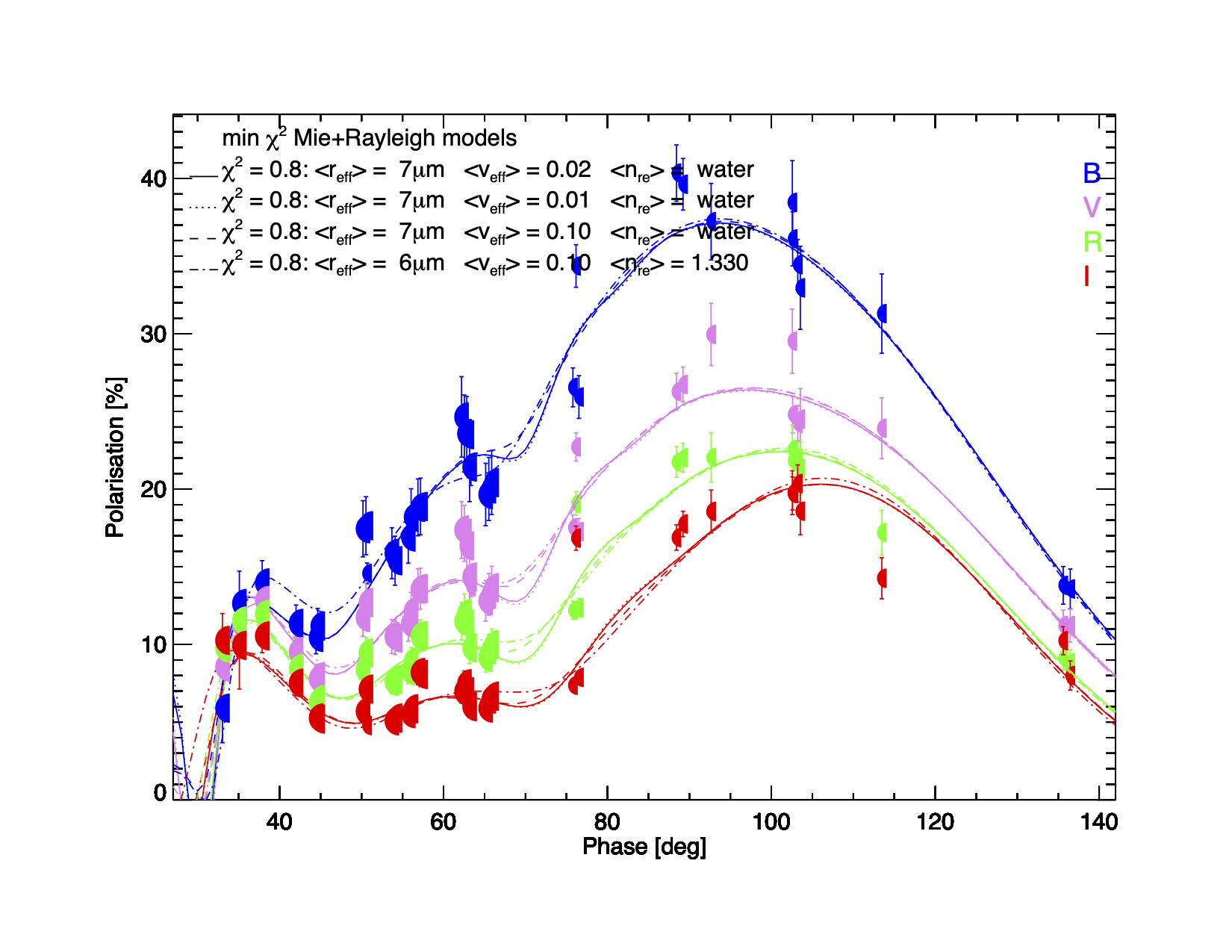What does a planet's rainbow tell us about its clouds?
31.07.2020

Or with other words "What does the earthshine (the shaded part of the moon) tell us about clouds on Earth?"
The phase curve of a planet describes its brightness as a function of phase angle (angle between incident light and observer). The phase curve of planet Earth is essentially determined by Rayleigh scattering at molecules and Mie scattering at water droplets. Scattering at spherical water droplets produces the rainbow feature at a phase angle of approximately 40°. The exact position of the rainbow and its width is determined by the droplet size and the chemical composition of the droplets. Since the unpolarized sunlight is polarized by scattering, the contrast of the rainbow can be enhanced with the help of a polarizing filter.
Observations of the Earthshine (reflected light of the dark side of the moon) with the VLT (Very Large Telescope) of ESO allows us to derive the phase curve of planet Earth. The photo shows the thin crescent Moon setting over ESO's Paranal Observatory with the VLT in Chile. As well as the bright crescent the rest of the disc of the Moon can be faintly seen. This phenomenon is called earthshine (Photo by ESO/B. Tafreshi).
For the first time, polarimetric spectra of the Earthshine have been observed for phase angles between 33° and 65° including the rainbow.
By comparison to model simulations using our radiative transfer model MYTSIC, we found that the refractive index of the cloud droplets corresponds to that of water, as expected, and that the mean effective radius of the droplets is between 6 and 7 µm. Including Rayleigh scattering in our analysis enabled us to derive a mean cloud cover of about 0.3 for liquid water clouds and to constrain the mean liquid cloud optical thickness to a range between 10 and 20.
Our results demonstrate, that observations of polarimetric phase curves of planets beyond the Solar System shall be extremely valuable for a thorough characterization of their atmospheres.
The Earthshine observations and their analysis have been published in the journal Astronomy & Astrophysics:
The Cloudbow of Planet Earth Observed in Polarisation: Sterzik, M. F., Bagnulo, S., Emde, C., & Manev, M. (2020): Astronomy and Astrophysics, 639, A89, https://www.aanda.org/articles/aa/full_html/2020/07/aa38270-20/aa38270-20.html
Was verrät uns der Regenbogen eines Planeten über dessen Wolken?
Die Phasenkurve eines Planeten beschreibt seine Helligkeit als Funktion des Phasenwinkels (Winkel zwischen einfallendem Licht und Beobachter). Die Phasenkurve der Erde wird wesentlich durch Rayleigh-Streuung an Molekülen und durch Mie-Streuung an Wolkentröpfchen bestimmt. Streuung an kugelförmigen Wolkentröpfchen erzeugt den Regenbogen bei einem Phasenwinkel von etwa 40°. Die genaue Position des Regenbogens und dessen Breite wird durch die Tröpfchengröße und die chemische Zusammensetzung der Wolkentröpfchen bestimmt. Da das unpolarisierte Sonnenlicht durch Streuung polarisiert wird, kann der Kontrast des Regenbogens mit Hilfe eines Polfilters deutlich verstärkt werden.
Die Phasenkurve der Erde kann mit dem VLT (Very Large Telescope) der ESO mittels des Erdscheins, also des reflektierten Lichts von der dunklen Seite des Mondes, beobachtet werden. Das Foto zeigt die schmale Mondsichel über dem Paranal-Observatorium der ESO mit dem VLT in Chile. Neben der hellen Sichel ist auch die restliche Mondscheibe, der Erdschein sichtbar. (Herkunftsnachweis: ESO/B. Tafreshi)
Polarisationsspektren des Erdscheins wurden zuletzt erstmals für Phasenwinkel zwischen 33° und 65° gemessen.
Durch Vergleich mit Modellsimulationen, welche wir mit unserem Strahlungstransportmodells MYSTIC durchgeführt haben, konnten wir zum einen feststellen, dass der Brechungsindex der Tröpfchen - wie erwartet - dem von Wasser entspricht und dass die mittlere Wolkentröpfchengröße zwischen 6 und 7 µm liegt. Des Weiteren konnten wir durch Hinzunahme der Rayleighstreuung einen mittleren Bedeckungsgrad von etwa 0.3 für die Flüssigwasserwolken ableiten und deren mittlere optische Dicke auf einen Bereich zwischen 10 und 20 einschränken.
Unsere Ergebnisse zeigen, dass die Beobachtung polarimetrischer Phasenkurven für die Charakterisierung der Atmosphären anderer Planeten außerhalb unseres Sonnensystems sehr hilfreich sein können.
Die Erdschein-Beobachtungen und deren Auswertung wurden in der Zeitschrift Astronomy & Astrophysics veröffentlicht:
The Cloudbow of Planet Earth Observed in Polarisation: Sterzik, M. F., Bagnulo, S., Emde, C., & Manev, M. (2020): Astronomy and Astrophysics, 639, A89
https://www.aanda.org/articles/aa/full_html/2020/07/aa38270-20/aa38270-20.html


